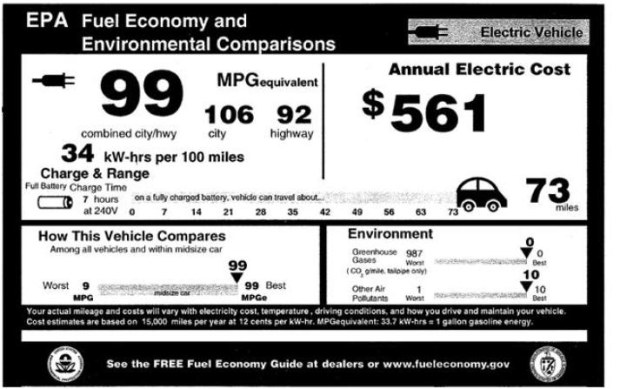
2011 Nissan Leaf

2011 Nissan Leaf window sticker showing 99-MPG
My hunch, though I haven’t seen the EPA comment yet, is that the EPA believes it has to make the efficiency figures comparable to what the majority of consumers are used to as it relates to the automobile. That measurement is Miles Per Gallon (MPG). This is where we bring in the AllCarsElectric.com argument. Nikki Gordon-Bloomfield writes, “It’s not Nissan. It’s the EPA’s test procedure. In the simulated tests the resulting figures are adjusted downward in such a way that makes it almost impossible for an electric car to achieve the range in testing its manufacturers claim.” We get it, the testing procedures were originally developed for the internal combustion engine and might not be optimal for electric cars.
Here is my, albeit young 20-something, take on the matter. From a marketing perspective, the MPGe makes plenty of sense because there are people out there who still can’t get their head around computer-controlled engine management. To ask people, especially young non-automotive consumers, to know what they are paying for their kilowatt-hours may not be reasonable; to prove my point I looked up my most recent energy bill and there are no less than seven different tiers and adjustments that change the cost of my kilowatt-hours. If you do a rough monthly cost divided by usage I am paying an estimate 14 cents per kilowatt-hour, but as a consumer knowing that a LEAF goes 100 miles on what is roughly 1 gallon is more powerful than any kilowatt-hours information. It is a bunch of work to ask the average consumer calculate a new method when electric cars don’t even make up 1% of vehicles on the road. No doubt the kilowatt-hours method is more accurate, but it is also a method and policy that would have to be put in place—something that is hard for government agencies to execute quickly. So from an adoption perspective I believe the MPGe actually makes it easier for people to consider adopting an electric vehicle.
Going back to Gordon-Bloomfield’s discussion. Every car goes through the same tests right now at the EPA. According to scientific method if you start changing the variables then you aren’t comparing like situations. That doesn’t mean that a new procedure for electric vehicles shouldn’t be looked at…however, I do believe that the EPA is showing how the LEAF performs when treated like every other internal combustion engine vehicle on the road—and really that is what the public wants to know. Sure, an electric can get 100 miles on a charge, but would the average driver, one that doesn’t know a stitch about hypermiling techniques or pulse and glide, be able to achieve it driving an electric the way they drive their current car. That manner, by the way, is generally without any regard for what is going on with the car—just go to Chicago and ride in a hybrid cab. I can tell you from first hand experience that they aren’t using the benefits of a hybrid to their advantage.
Bottom line—Is the EPA’s test accurate? I believe so if they are showing how that particular EV handles the exact same test that any internal combustion engine vehicle would be put through. Is Nissan wrong about the 100 miles per charge figure? No, because it has been verified as part of truth in advertising by the Federal Government. The disconnect? People will have to change their driving habits to achieve the full range of an electric vehicle with the current state of the technology. Currently, an electric vehicle isn’t the equivalent to an internal combustion engine. It doesn’t make it bad technology; it just makes it different and very valuable given the right situation. I can’t wait to own one some day…but I am still keeping my lead sled of a 1972 Cadillac Eldorado Convertible and the whole 10 mpg it may get in the city.












